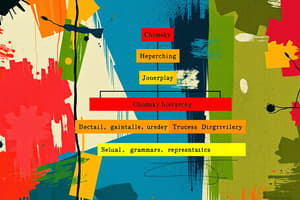Podcast
Questions and Answers
What is the type of languages that can be recognized by a finite automaton?
What is the type of languages that can be recognized by a finite automaton?
- Type 1
- Type 3 (correct)
- Type 0
- Type 2
Which of the following is a closure property of regular languages?
Which of the following is a closure property of regular languages?
- Complementation (correct)
- Distributivity
- Associativity
- Commutativity
What is the term for languages that can be generated by a context-free grammar?
What is the term for languages that can be generated by a context-free grammar?
- Recursively enumerable languages
- Context-free languages (correct)
- Regular languages
- Context-sensitive languages
Which of the following languages is an example of a context-free language?
Which of the following languages is an example of a context-free language?
What is the type of languages that can be generated by a context-sensitive grammar?
What is the type of languages that can be generated by a context-sensitive grammar?
Which of the following languages is an example of a recursively enumerable language?
Which of the following languages is an example of a recursively enumerable language?
What is the term for languages that cannot be recognized by a Turing machine?
What is the term for languages that cannot be recognized by a Turing machine?
What is the relationship between the levels of the Chomsky hierarchy?
What is the relationship between the levels of the Chomsky hierarchy?
Flashcards are hidden until you start studying
Study Notes
Chomsky Hierarchy
Regular Languages
- Type 3: Languages that can be recognized by a finite automaton (FA)
- Closure properties:
- Union: The union of two regular languages is regular
- Intersection: The intersection of two regular languages is regular
- Complementation: The complement of a regular language is regular
- Concatenation: The concatenation of two regular languages is regular
- Examples:
- Language of all strings consisting of only 0s and 1s
- Language of all strings with an even number of 0s
Context-free Languages
- Type 2: Languages that can be generated by a context-free grammar (CFG)
- Closure properties:
- Union: The union of two context-free languages is context-free
- Concatenation: The concatenation of two context-free languages is context-free
- Examples:
- Language of all palindromes
- Language of all strings consisting of balanced parentheses
Context-sensitive Languages
- Type 1: Languages that can be generated by a context-sensitive grammar (CSG)
- Closure properties:
- Union: The union of two context-sensitive languages is context-sensitive
- Concatenation: The concatenation of two context-sensitive languages is context-sensitive
- Examples:
- Language of all strings consisting of a sequence of 0s and 1s with equal numbers of 0s and 1s
- Language of all strings consisting of a sequence of 0s and 1s with the number of 0s being a multiple of the number of 1s
Recursively Enumerable Languages
- Type 0: Languages that can be recognized by a Turing machine (TM)
- Closure properties:
- Union: The union of two recursively enumerable languages is recursively enumerable
- Concatenation: The concatenation of two recursively enumerable languages is recursively enumerable
- Examples:
- Language of all strings that can be accepted by a TM
- Language of all strings that can be generated by a TM
Unrestricted Languages
- Type 0: Languages that cannot be recognized by a Turing machine (TM)
- Examples:
- Language of all strings that are not recursively enumerable
- Language of all strings that are not Turing recognizable
Note: The Chomsky hierarchy is a containment hierarchy, meaning that each level is a subset of the level above it.
Chomsky Hierarchy
Regular Languages
- Type 3: Recognized by a finite automaton (FA)
- Closure properties: Union, Intersection, Complementation, and Concatenation are all regular
- Examples:
- Language of all strings consisting of only 0s and 1s
- Language of all strings with an even number of 0s
Context-free Languages
- Type 2: Generated by a context-free grammar (CFG)
- Closure properties: Union and Concatenation are context-free
- Examples:
- Language of all palindromes
- Language of all strings consisting of balanced parentheses
Context-sensitive Languages
- Type 1: Generated by a context-sensitive grammar (CSG)
- Closure properties: Union and Concatenation are context-sensitive
- Examples:
- Language of all strings consisting of a sequence of 0s and 1s with equal numbers of 0s and 1s
- Language of all strings consisting of a sequence of 0s and 1s with the number of 0s being a multiple of the number of 1s
Recursively Enumerable Languages
- Type 0: Recognized by a Turing machine (TM)
- Closure properties: Union and Concatenation are recursively enumerable
- Examples:
- Language of all strings that can be accepted by a TM
- Language of all strings that can be generated by a TM
Unrestricted Languages
- Type 0: Not recognized by a Turing machine (TM)
- Examples:
- Language of all strings that are not recursively enumerable
- Language of all strings that are not Turing recognizable
Containment Hierarchy
- Each level is a subset of the level above it
- The hierarchy is a containment relationship between the language types
Studying That Suits You
Use AI to generate personalized quizzes and flashcards to suit your learning preferences.



